This delicious yeasty French bread recipe has only one 20-minute rise before going into a screaming hot oven for another 20 minutes. At the end you have golden crusty goodness just waiting to be slathered in butter or dipped in oil and balsamic! One hour, I promise!! Originally posted February 23, 2017.
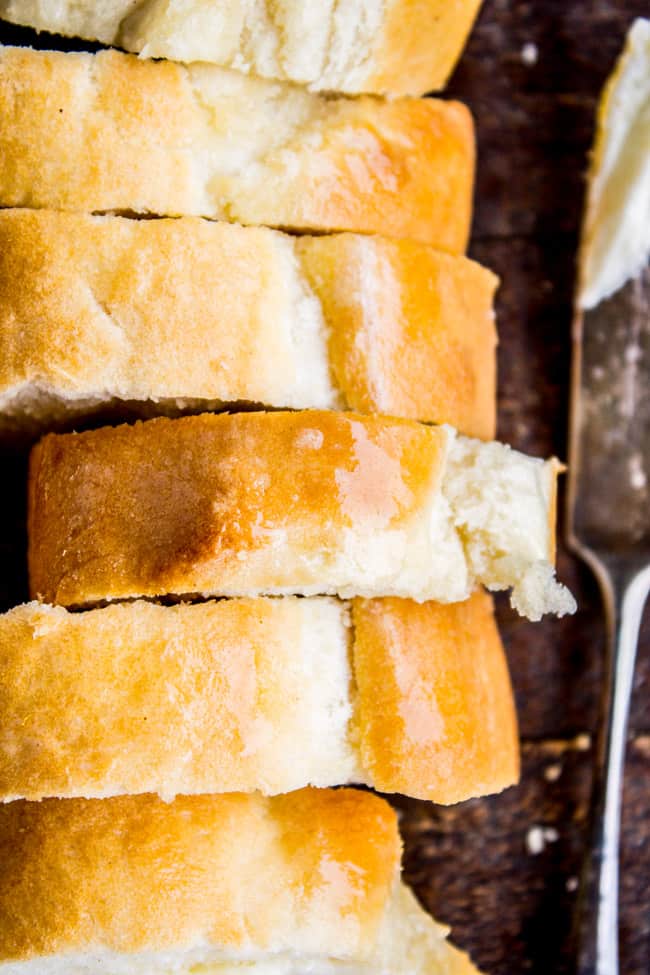
Table of Contents
- How to make French Bread (in one hour!)
- Easy French Bread Recipe Ingredients
- Best French Bread Recipe Variations and Substitutions
- What to eat with Easy French Bread
- How to keep French Bread fresh
- Can you freeze French Bread?
- Quick French Bread Recipe FAQs
- Other bread recipes to try!
- One Hour French Bread Recipe Recipe
Eric got home from work today and came into the kitchen (where else would I be) to say hello. After we hugged, I was stirring something on the stove when I heard him counting under his breath. 1…2…3…4…and on 5, he shut the fifth cupboard door that I had left open while making dinner. (He even dinged as a reinforcing tactic.)
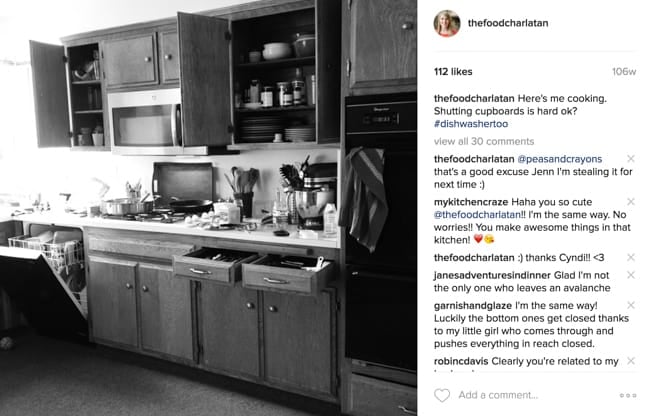
I took this photo over a year ago. You would think I would learn (because I smack my head all the time) but usually when I’m cooking I’m in a hurry. My brain subconsciously thinks to itself, “you don’t have time to shut that drawer right now. You gotta get this cumin in the taco meat STAT.” Or whatever it is I need to do next.

It’s gotten to the point that whenever I bend over in my kitchen to put something away, I try to remember to come up slowly and check around for rogue cupboards. We got a new fridge a few months ago and it starts beeping at me when I leave it open. This happens approximately 12,000 times a day.

After he counted the open cupboards, Eric probably turned around and started counting children. 1…2…3…4…5…6…7. I have 7 children under the age of 7 in my house right now. (Ages 6, 6, 5, 4, 3, 1, and 3 months. I think.) My best friend and her husband are on a trip to Sweden (!!) and I volunteered to take her 4 kids for a week. No one is dead yet, thank you very much. Pray for me, my friends. Pray no one dies, and that if they do, that it wasn’t by my hand.
How to make French Bread (in one hour!)
So who’s got 3+ hours to make French bread for dinner tonight? Not this girl. (Hello, just start counting the kids in my house.) But I think I could handle 1 hour bread. This stuff is SO good. I’m not sure that I’ll ever go back to my trusty double rise French bread. I mean, that recipe is delicious, but so is this one, and ONE HOUR!
“How is this possible? you ask yourself, twirling your imaginary little French mustache. “How can it only take one hour?”
Well mon ami, we are going to use the power of yeast to our advantage. Using a little more than usual helps this French bread rise super fast so we can pop it in a hot oven and get to shoving it in our faces faster than you can say “Bonjour!” (No, my knowledge of French does not extend beyond the opening scene of Disney’s animated Beauty and Beast and I am FINE with that). Before you know it you’ll be digging into the crusty-on-the-outside, soft and fluffy on the inside French loaf of your wildest dreams.
What is French Bread?
That depends on whether you’re buying it from a boulangerie in Paris or picking up a $2 loaf at your grocery store. In France, it is actually against the law to sell French bread with any added oil or fat! In the US, that loaf you’re grabbing on your 5PM Walmart run has no such special rules. Basically, French bread is like a wide baguette; it’s made of flour, salt, yeast, and water, and in the US it may also have a small amount of added fat and sugar. It’s endlessly versatile for serving with a meal, spreading with butter and jam or cheese, or making French toast, strata, croutons, garlic bread, pizza…you get the idea. The French bread we’re making today is made of the basic four ingredients and also includes a small amount of fat and sugar. We’re going for delicious, easy, and fast here, not trying to meet strict French bakery standards.
French Bread vs Baguette
French bread is wide; a baguette is skinny. French bread is crusty, but it doesn’t have the truly chewy thick crust of a baguette. Baguettes need a special pan to rise in, but French bread can be made on a baking sheet. Both are delicious, but French bread is better suited to repurposing to make garlic bread or French toast.

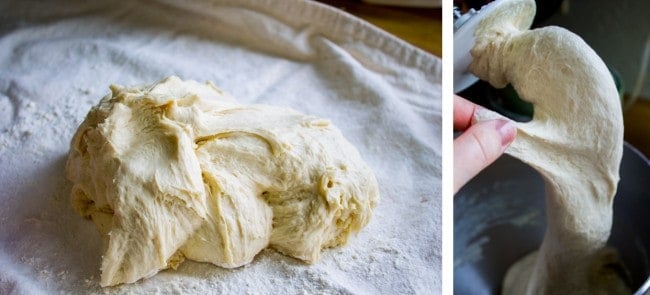
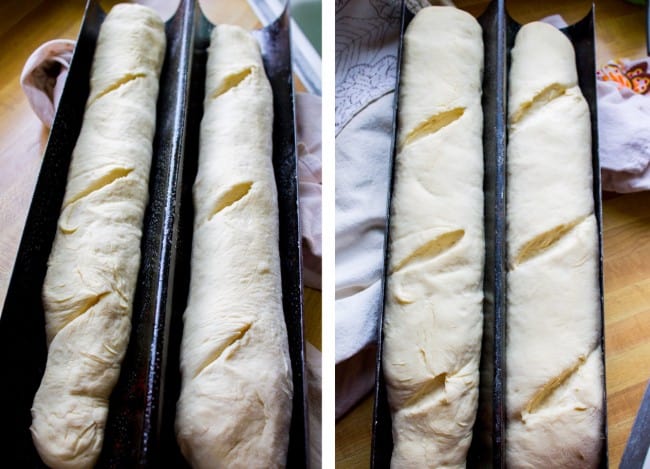
This French bread recipe has got the most gorgeous crust, and yes, part of that is because of the baguette pan that I used. (It’s not the one I linked too, that’s just a similar one.) Eric’s grandma (Nana) gifted me her old baguette pan and I get excited every time I use it. I love the crispy crust it makes all over the bottom. But you can totally shape the loaf on a regular old baking sheet, no fancy pans required. It will still be delicious bread in the end. Soft and tender in the middle, crispy crust on the outside. Yes please! Pass the butter.

Easy French Bread Recipe Ingredients
Here’s a quick shopping list to help you gather your ingredients. See the recipe card below for the full ingredients and instructions!
- Sugar
- Active dry yeast
- Butter
- Flour
- Egg white (optional)
Best French Bread Recipe Variations and Substitutions
French bread is a classic recipe. While the basic ingredients should remain the same, you can switch up the way you use it! Here are some ideas:
- Slice your French bread and lay out the slices on a baking sheet. Spread each one with softened butter, then sprinkle them with garlic salt. Put them under the broiler for 2-3 minutes on high, and voila! Garlic toasts to go with your spaghetti.
- Take uneaten slices of French bread (lucky you, that never happens at my house) and make French toast with them.
- Cube leftover bread and use it in this Strawberry Panzanella Salad.
- Make it into French Bread Pizza (3 Ways).
- Get super fancy and up your breakfast game with this Grilled Cheese Eggs Benedict.
- Love Jalapeno poppers? If you’ve never tried these Jalapeno Popper Grilled Sandwiches you are in for a treat (and french bread is great in these).
What to eat with Easy French Bread
Um…is this a trick question? The answer is a generous amount of soft butter and my bare hands, right?
If you’re not planning on taking the loaf down like a starving peasant (guilty), here are some of my favorite meals to serve French bread with.
Easy Broccoli Cheese Soup (30 Minutes) << is there anything better than dipping warm bread in warm cheese sauce? And there’s broccoli, so it’s HEALTHY.
Best Beef Bourguignon Recipe << while we’re pretending to be in Paris, let’s go full French and make this. Not nearly as easy but the payoff is soooo worth it.
Zuppa Toscana Recipe << this creamy, slightly spicy broth is just begging for you to dip some warm crusty bread in it.
Best Chicken Alfredo Recipe << creamy Alfredo sauce + French bread = true love.
30 Minute Pesto Penne with Chicken and Cherry Tomatoes << one of those perfectly simple, super flavorful meals that everyone loves.

How to keep French Bread fresh
French bread can be stored on the countertop for up to 3 days, or in the fridge for up to a week. But I don’t recommend that you do either! After you serve it the first time, slice the rest of the loaf and put the slices in a ziplock bag. Keep them in the freezer and pull out the exact number of slices you want, anytime you want, and warm or toast them to your liking. They’ll stay much fresher this way.
Can you freeze French Bread?
Yes! French bread can be frozen as an entire loaf or in slices. If you freeze the entire loaf you should first wrap it tightly in plastic wrap, then in tin foil. If you slice it first, you can simply pop them into a ziplock bag and pull it out anytime.
Quick French Bread Recipe FAQs
Traditional French bread is made with only four ingredients: flour, water, salt, and yeast. American white bread, in loaf form or as dinner rolls, tends to include sugar and fat (like butter, oil, or shortening). They tend not to have a crisp crust, but instead are soft inside and out. This French bread recipe includes a small amount of butter and sugar but still has that delicious, beautifully golden-brown crust. French bread is also shaped by hand rather than being baked into a loaf of an exact size and shape.
The French bread you actually get in France is made with different flour than we use here in US. It has a higher grain content and fewer minerals from the milling process. Also, there’s a special rule for bakeries in France that the dough for bread MUST be made at the same location where it is baked. Many bakeries around the world bake their rolls, bread, and pastries from dough that was made at a different location, then shipped to that bakery in a refrigerated or frozen state. This means that a lot of French bread is fresher than what you’d get elsewhere.
French bakers use different flours depending on the type of bread they’re making. For example, they use different flours for baguettes and croissants. For baguettes, many French bakers use Type 55, or T55 flour, which you can purchase online. One thing to know is that much of the flour we buy in the US comes from wheat made in Canada, and it has a higher gluten content than the flour used in France. That means that French bread is softer. For the French bread we’re making today, all purpose flour is what we want, rather than bread flour, which has a higher gluten content.
Yes, you definitely can. If you over knead bread, it will be dense and tough (gross). If your dough is starting to get difficult to stretch, or it feels stiff or dense, you’ve gone too far. Kneading with your stand mixer (or your hands) for 6-7 minutes, as recommended in this recipe, should be just the right amount.
When French bread doesn’t come out with that nice, crispy crust we know and love, it’s truly disappointing. Starting with a nice, hot 450 degree oven that’s been preheated for at least 20 minutes ensures you’ll get crusty French bread. You’ll also want to make sure that you’ve baked it long enough. If you’re making one big loaf instead of two smaller ones, your bread may need more time. Don’t be afraid to let it get nice and golden brown on top!
You want your French bread light and fluffy on the inside with a nice crispy crust. Here’s how to make sure it happens:
Don’t kill your yeast. The water in which you prove your yeast should be warm, NOT hot. And don’t use old yeast! Once you’ve opened it, it’s only good in the fridge for 4 months and the freezer for 6.
Let your bread rise. This is one-hour bread, but we’re still going to let it rise for 20 minutes. The extra yeast in this recipe will get the job done.
Give your oven time to preheat. When you put your bread into a super hot oven, it actually keeps rising! During the first few minutes that your French bread is in there, it’s going to get even bigger than it already did on the counter. Bigger bread = lighter, fluffier inside.
By the way, you should totally take an extra 5 minutes and make this Restaurant-Style Olive Oil and Balsamic Bread Dip. HEAVENLY! If you make any of my recipes, be sure to share them on Instagram using the hashtag #TheFoodCharlatan so I can see it! I love that.
Other bread recipes to try!
Garlic Knots Recipe << These are soooo worth it. Big fancy knots dipped in the garlic butter of your DREAMS.
Big Fat Crescent Rolls << so beautiful (and really not that hard). I’ll show you how!
One Hour Yeast Rolls (Reesy Rolls) << this was a classic for Eric growing up. You can tell by this photo I posted these a long time ago!
Aunt Shirley’s Famous Dinner Rolls << these are my family’s must-have rolls for every occasion.
Garlic and Rosemary Skillet Bread << Alllll the garlic on top, baked in a cast iron skillet. So good.
Buttery Sweet Potato Rolls << not just for Thanksgiving!
Classic Crusty Herbed Dinner Loaf from Sugar Dish Me
5 Seed Dinner Rolls from Sprinkles and Sprouts
Savory Onion Cheese Rolls from Mindee’s Cooking Obsession
Facebook | Pinterest | Instagram
One Hour French Bread Recipe

Ingredients
- 1 & 1/2 cups warm water
- 1 tablespoon white sugar
- 1 & 1/2 tablespoons dry yeast*
- 1 & 1/2 teaspoons salt
- 1 & 1/2 tablespoons butter, softened
- 3-4 cups all purpose flour, spooned and leveled
- 1 egg white, optional (for brushing)
Instructions
- Preheat your oven to 450 degrees. Do it now so that your oven is nice and hot when you put the bread in.
- In a large bowl or stand mixer, combine warm water, sugar, yeast, and salt. You want the water to be like a nice warm bath water. Feel it with your wrist.
- Set your bowl on the preheating oven and wait a couple minutes. If you see bubbles from the yeast reacting, move forward. If not, you may have killed your yeast with too hot water. Dump it and start over!
- Add the softened butter and 1 cup of flour, and stir together with a wooden spoon.
- Use the dough hook (or continue with the wooden spoon) to stir in the rest of the flour. Start with 3 cups total in the recipe (including the cup you added in step 4). Then add the last cup 1/4 cup at a time to see how much you need. The dough should be pulling away from the sides of the bowl but still sticky. (see photos) I usually add most of the fourth cup.
- Knead for 6-7 minutes, until the dough is smooth and elastic.
- Prepare a baking sheet or baguette pan** with nonstick spray.
- At this point you can either shape the dough into one large loaf that is about 12-14 inches, or you can make 2 smaller loaves. (I made two smaller loaves to fit in my baguette pan.)
- Use a sharp serrated knife to make 3-4 half-inch slits on top.
- Cover with a tea towel and let rise for 20 minutes.
- When the loaf or loaves have roughly doubled in size, remove the towel.
- In a small bowl, use a fork to whisk up 1 egg white. Make it nice and frothy. Use a pastry brush to coat the tops and sides of the bread. You can use all or most of the egg white.
- Transfer the bread to the oven.
- Bake for about 20 minutes. You will know it is done when the top is shiny and golden, and the bottom of the loaf is browned. The longer you leave it in, the crispier your crust will be.
- Let cool for a bit and then devour hot with butter!
Video
Notes
Nutrition
This post contains affiliate links. Thanks for your support!
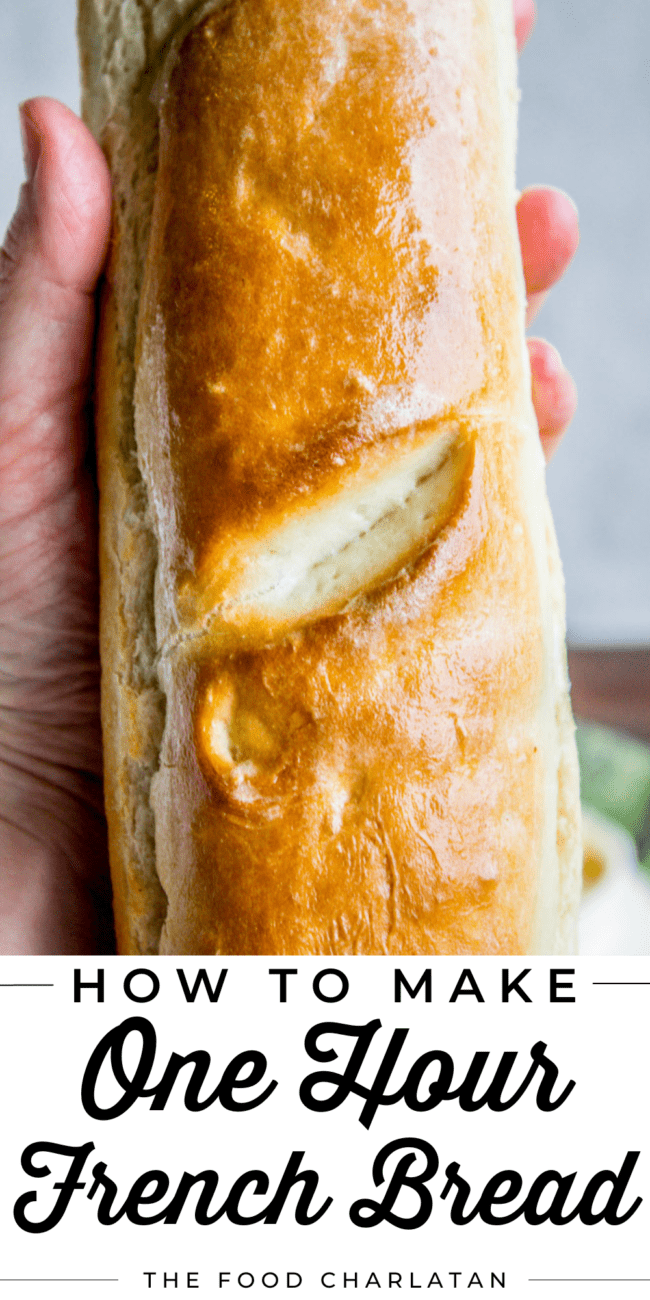
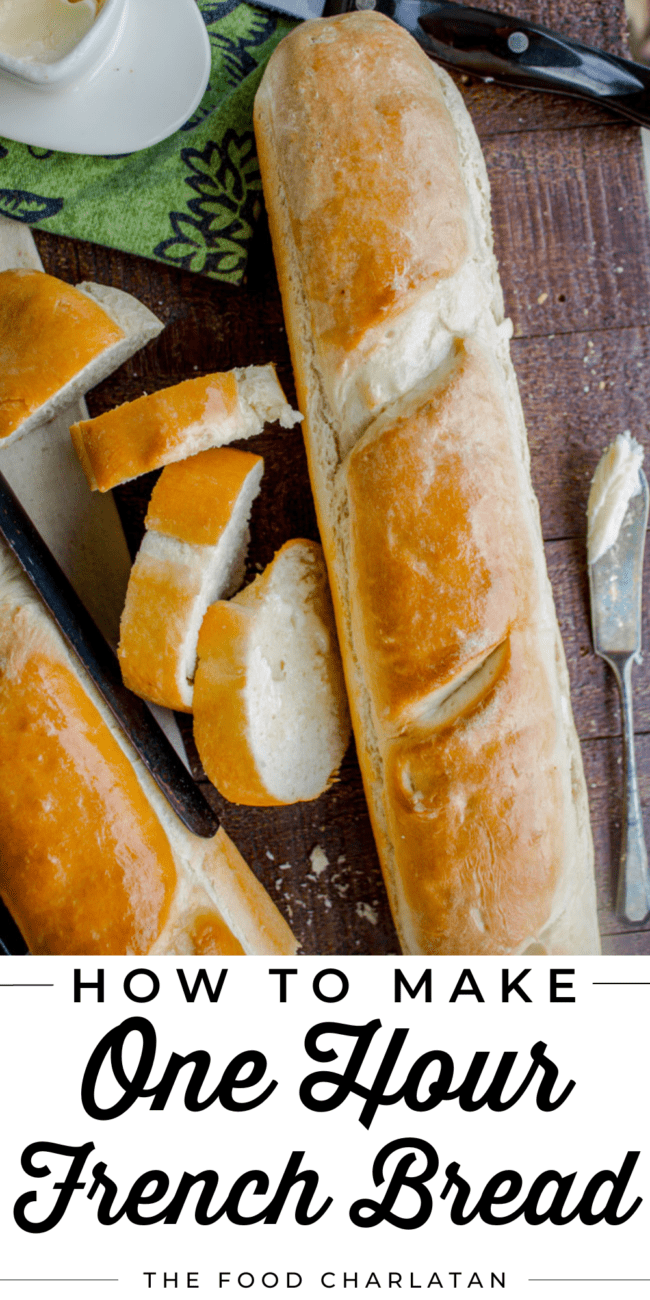
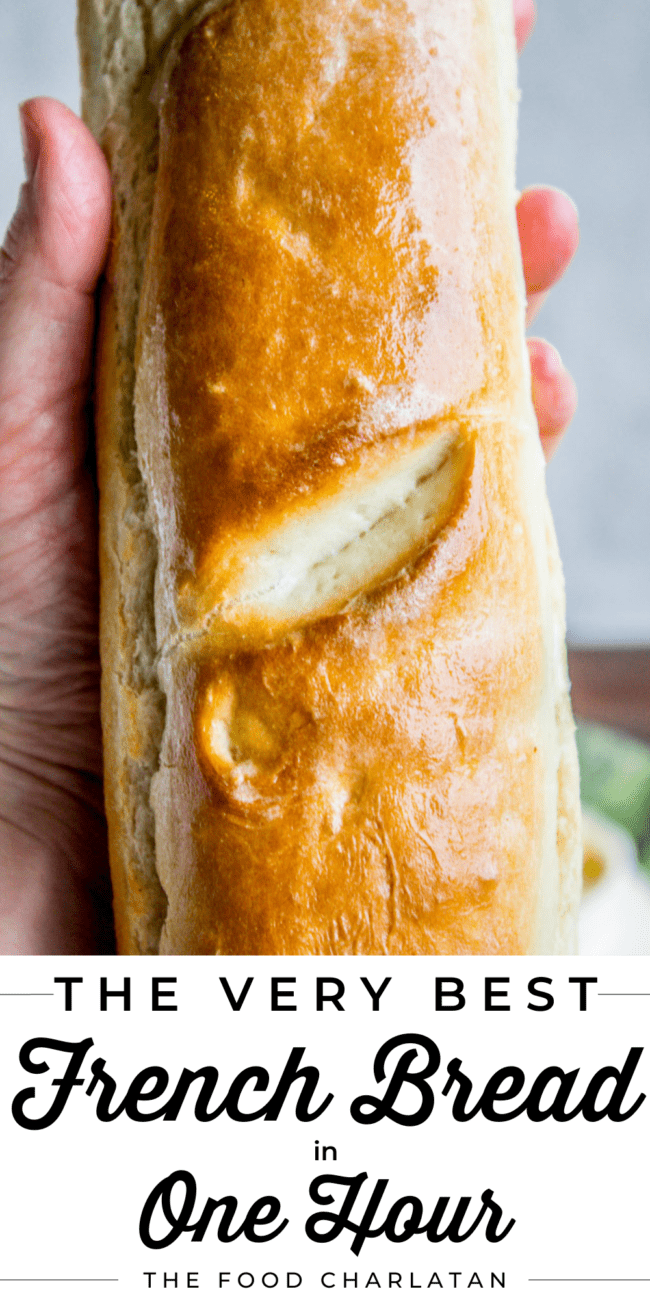
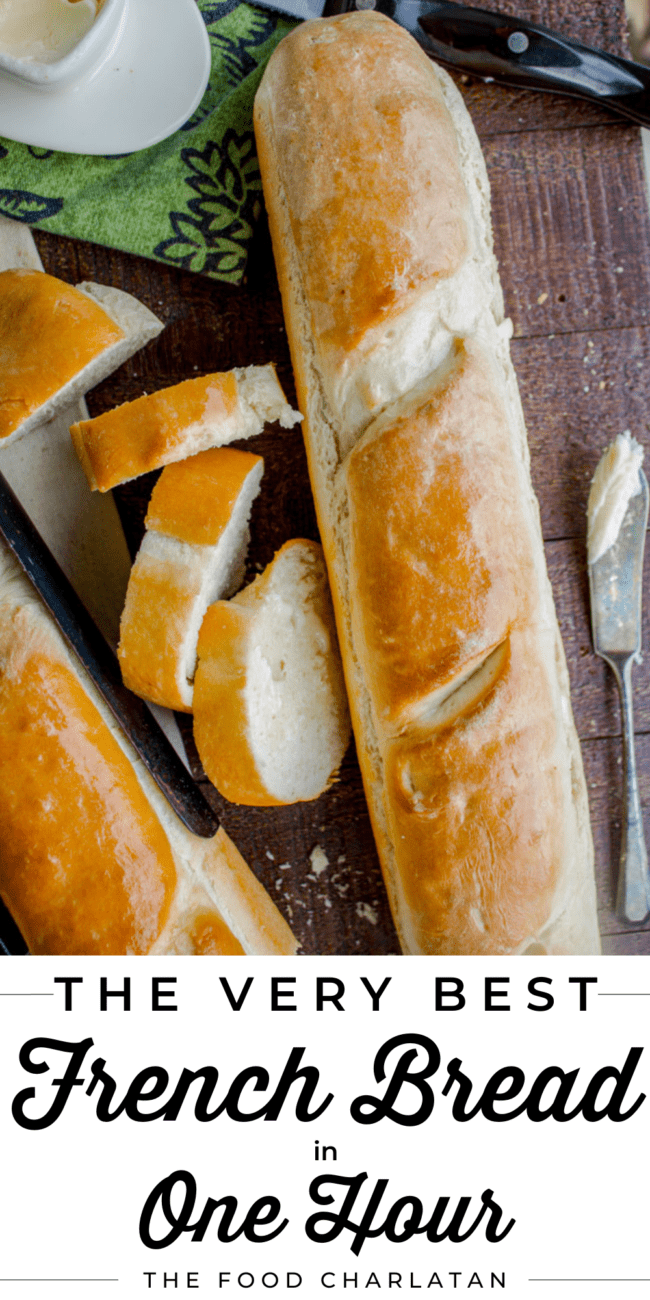

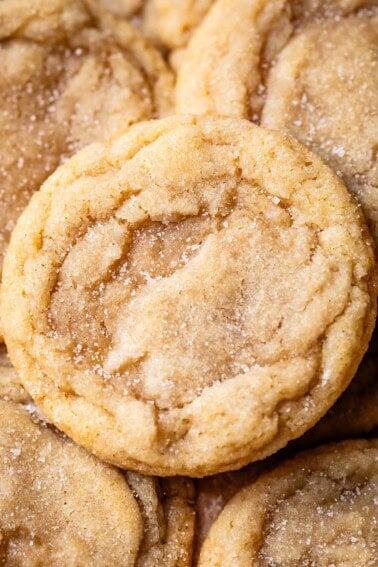
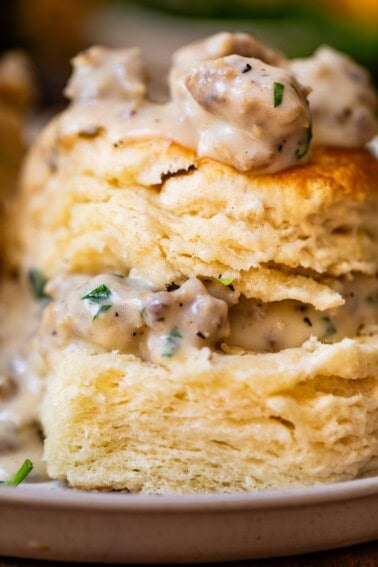

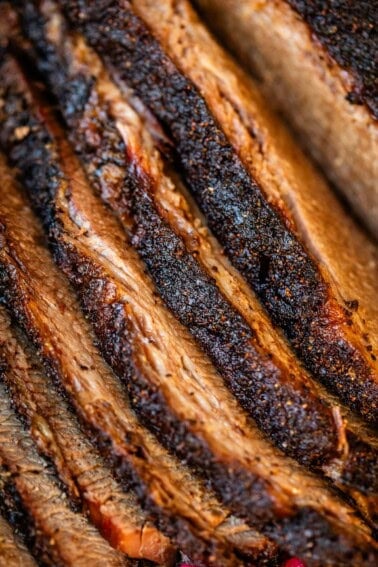









This is a great recipe. It was the My first French loaf and it worked exactly ass described.
So happy to hear this Karen! Thank you so much for reviewing!
My friend gave me this recipe after I asked for a bread recipe that I wouldn’t manage to bungle. Sweet breads, quick breads, and flat breads? No problem. But regular bread has evaded me for YEARS whenever I’ve tried to make any. This recipe is the first that’s come out perfect, which is saying something! I think the photos of various steps really helped.
I’m so happy to hear the photos were helpful Nelson! And so glad you’ve found a recipe that works for you, that’s the best feeling! Thanks so much for reviewing :)
Question on step 3 – put the yeast mixture ON or IN the preheating oven? We have wall ovens so unsure what to do …
Thank you!
Hi Maureen! This is a really good point, thanks for asking! I put mine ON top of the oven while it’s preheating. If you have a wall oven then I would turn the oven on to 350 for about 1 minute, then turn the oven off. It should be warm not hot. The yeast mixture just needs to sit in a warm environment for a few minutes. Hope this helps!
This bread is FANTASTIC! My whole family raved. I did substitute bread flour for half of it because I made one large loaf and thought it would give it more structure. Since I made this during self-quarantine and eggs are in short supply, I skipped the egg wash, but brushed it with soft butter when it came out of the oven. I served it with homemade soup and leftovers were PERFECT sandwich bread!
So glad the recipe was a success! Thanks for the review Stephanie!
Something is off with this recipe (or off with me).
Every time I make it, I have to use closer to 6 cups of flour just to be able to handle it, and the instructions aren’t very clear whether you knead 6-7 minutes by hand or in the mixer, and if in the mixer, at what speed.
I was also taught to *never* add the salt with the water, sugar, and yeast, because it kills the yeast.
The bread always comes out sufficiently tasty, but I feel like I have to significantly alter the recipe to get it to work for me.
Hi CH! The flour level for bread is dependent on so many things that it’s not possible to give an exact amount, which is why flour amounts are given in ranges. You can knead the dough in the mixer or by hand for 6-7 minutes, or until the dough is smooth and elastic. Salt does not kill yeast, but can slow down it’s growth. Add it in later if you like! Hope this helps!
Well then, I guess we’ll have fresh bread daily! Not at all yeasty or doughy.
This was so easy and worked out very well. I will definitely make it again with some tweaks.
Oh. My. Heaven. THANK YOU for sharing this recipe! I make it nearly every night! I had been searching for a good bread recipe for years, and this is it!
Oh man, come make this for me every night!! Haha! Clearly I’m not making this bread often enough. So glad you are enjoying it Sara! Thanks for reviewing!
I loved this one. Bread is one of my favorite things to make. This was a great recipe to take my stand mixer out for it’s very first bread run. :)
It’s one of my favorite things to make too Caitlin! It’s just so satisfying. Congrats on the new mixer! Very exciting!! I’m glad you like the French bread :)
Wow, thank you so much for sharing this amazing recipe! I generally suck at baking, especially with the complications of not being able to use any dairy (milk) products, but the first time I made this bread it turned out fine and my family loved it. The taste and texture actually remind me of Jimmy John’s sandwich bread, which I love…. Even with olive oil substituted for the melted butter it tastes delicious. Thank you!
That is awesome Sage! What a success story! I’ll take a loaf of Jimmy John’s sandwich bread any day ;) Good idea to use olive oil. Thanks for the tips and review Sage!!
hi would i be able to use my bread machine to make this recipe and let it do the kneing for me and then shape in the pan
Yes absolutely! I always knead this in my kitchenaid.
Looks like a great recipe. Can I use instant yeast?
Hi Colleen! I haven’t tried it but it should work just fine. Let me know how it goes!
I can’t wait to try this. Will give you my feed back when the taste test is complete.
Please do report back! I hope you love it Debbie! I love this recipe!
Thank you thank you thank you! I have struggled with french bread forever! I’m going to try this! I did notice though that it’s a bit “denser” looking than most french bread? Is that due to the shorter rise time?
hmmmm I wouldn’t say this recipe is any more dense than your average French bread. I think it’s very light! Let me know how it goes and what you think when you make it Brian!
I recently got a french loaf pan so was anxious to try making it for the first time. This recipe was amazing! I’ve made bread before but never such a quick recipe. And I’ll tell you, this recipe felt like the amazing bread you get at good restaurants for dipping. It had awesome flavor! This will definitely be my go to french bread recipe from now on. Thanks so much for sharing!
Yay! I’m so glad you loved the bread Patricia! It’s a keeper! :)
Made this today and I won’t be repeating that mistake. I’ve wondered about these 1 hour breads and now understand that using what amounts to at least 3x the amount of yeast is just the wrong way to look at it. It results in the yeast only having time to produce carbon dioxide to stretch the gluten making the dough double in size very quickly. However, as any bread baker knows, the slower the rise the better the flavour. No surprise then that the loaf is tasteless, oddly textured and vaguely unpleasant. It also left me and my daughter with quite painful tummies for an evening and night – just way way too much yeast.
In future I will either take the time to make a proper loaf of bread or go to my standby Irish Soda Bread. Far tastier, quicker and with a vastly superior texture and crust.
Interesting review Barbara! I’m sorry it didn’t work out for you. I just made this again yesterday and was commenting to my husband about how happy I am with the recipe. Crunchy outside, tender soft interior, with great buttery flavor. I don’t think it is at all overly yeasty. I have many other recipes that use a similar level of yeast, such as these one hour dinner rolls
https://thefoodcharlatan.com/2012/10/29/reesy-rolls-one-hour-yeast-rolls/
and these One Hour Cinnamon Rolls
https://thefoodcharlatan.com/2013/02/08/one-hour-cinnamon-rolls/
It looks like you are from the UK? I’m wondering if we are using different kinds of yeast?? This is such a common recipe, you can find similar recipes all over the place. This is the brand of active dry yeast that I use: http://amzn.to/2y3BSTp
I hope this is helpful, and again I’m so sorry you had a bad experience!
I did not intend to imply that your recipe was at fault, and I apologise if that’s what came across. It was more an observation on the idea of one hour bread that is, as you rightly say, very common these days especially on Pinterest.
As I said, I’ve long been curious and used your recipe as one of the best written and clearest I found. I think it’s about expectation and experience of more traditional recipes that leads me to my personal conclusion. One hour bread is not for me. You are right, it does not taste overly yeasty. In fact, I would say it has no yeast flavour whatsoever, because the yeast does not get time to develop properly. All it can do is provide a visual approximation of the ‘double in size’ rule of traditional methods. The same chemistry is not actually taking place.
You’re also correct, I’m in the U.K. But I’m fairly sure active dried yeast is the same here as with you. Although I have discovered other differences in products between the two countries! There is a story about chilli powder that I won’t include!
In the end, it’s about choice, I’d rather make a soda bread if I don’t have time for a full dough development, it just suits me better, taste, texture and time wise, than a one hour yeasted option.